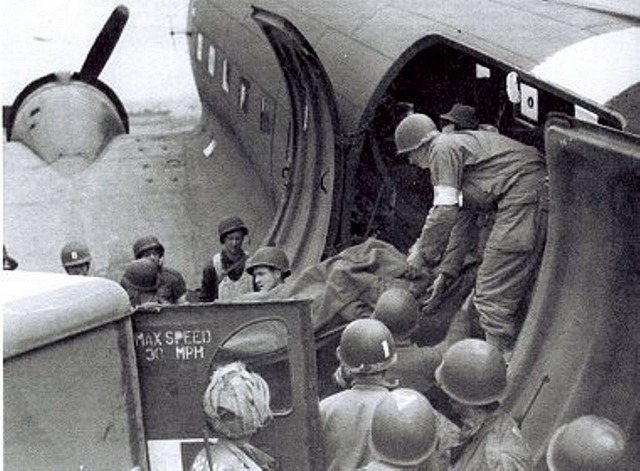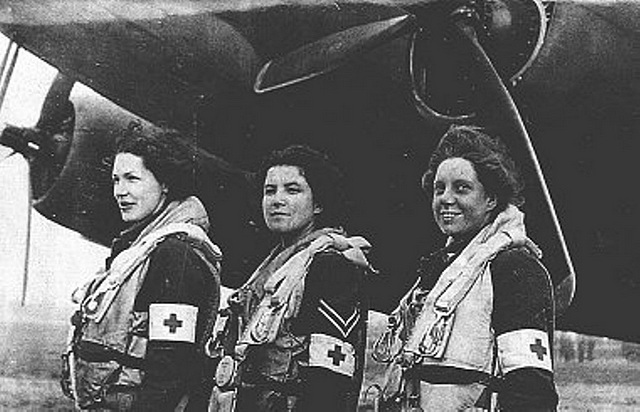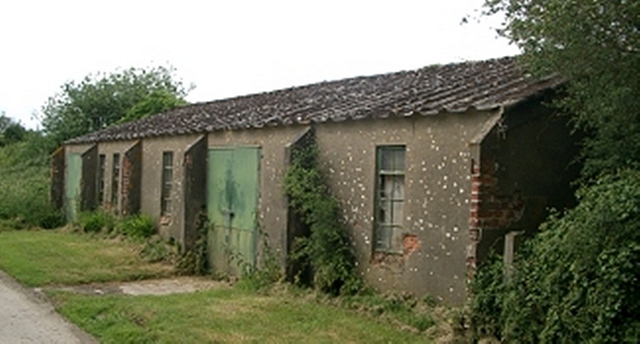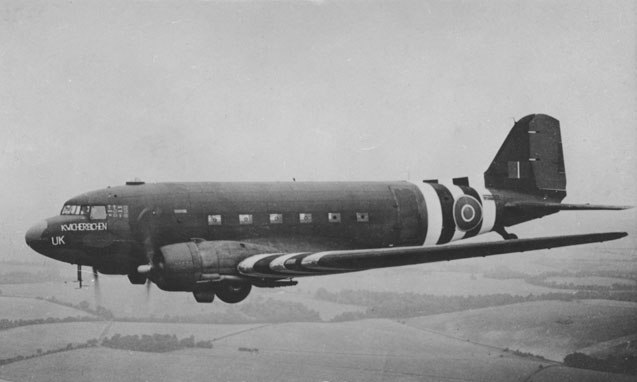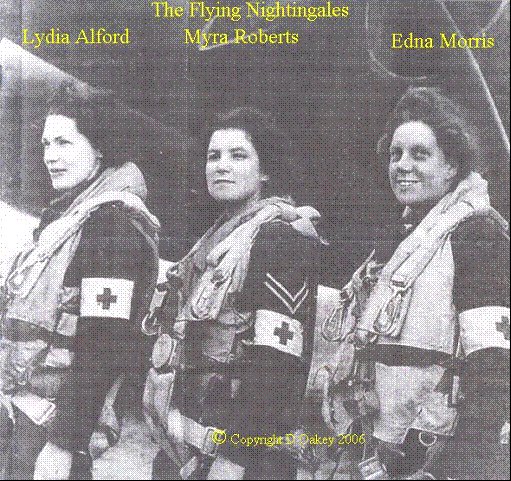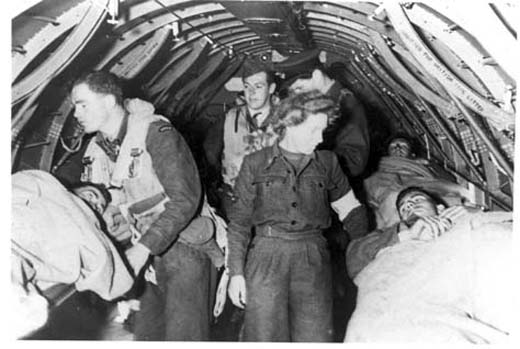The story of Colin`s photo showing the nurses that flew on the evac flights. the photo is of the first 3 WAAF nurses the flew to Normandy. here`s the obituary of Edna Morris & the story of "The Flying Nightingales" from the webpage: http://www.wospweb.com/site/RAF-Broadwell/
"The Flying Nightingales"
This is the obituary to Edna Morris who was not actually at RAF Broadwell but flew from RAF Blakehill Farm nr Swindon to deal with the casualties on D-Day, so she probable dealt with a good many men who flew from RAF Broadwell.
Edna Morris a nurse with the WAAF who was one of the first three women to fly to France after the D-Day invasion
Click on image for a larger version
EDNA MORRIS, who has died aged 80, was one of the first three women - known as "the Flying Nightingales" - to land in Normandy after D-Day; as a nursing orderly in the Women's Auxiliary Air Force (WAAF), she flew on the first RAF transport aircraft to evacuate the wounded from the French battlefields.
On the evening of June 5 1944, Edna Birkbeck, as she then was, was on duty at RAP Blakehill Farm, near Swindon, when the aircraft of her squadron, No 233, took off for Normandy. "Nobody mentioned an invasion, of course," she later .:,recalled, "but everybody knew."
On June 12, the nurses were called together to be briefed on the invasion by an RAF medical officer. Corporal Lydia Alford, LACW Myra Roberts and LACW Edna Birkbeck were asked to remain behind at the end of the briefing when they were told that they would be on the first casualty evacuation flights from .,;Normandy.
They were issued with parachutes and Mae West life jackets, which drew from one airman the comment, "Hey fellas, they're going in before we are". No Red Cross markings were allowed on the aircraft since they were transporting supplies.
Meanwhile in France, as soon as a foothold had been gained, the men of the Royal Engineer Airfield Construction Group had bulldozed a series of airstrips from the Normandy fields. The first was accepting RAF fighters the day after the landings, while the second, B2 at Bazenville near Bayeux, was rearming and re-fuelling Spitfire and Typhoon fighters two days later.
With the construction of more airstrips - 20 in the first two , months - there was sufficient capacity for transport aircraft to land with supplies. Since they would be empty for the return flight, casualties could be evacuated.
On D-Day+7 (June 13) three Dakotas of No 233 Squadron took off from Blakehill Farm and met an escort of Spitfires over Selsey Bill before heading for the B2 airstrip. On board each was a WAAF nursing orderly, including 20-year-old Edna Birkbeck. After four tons of supplies had been unloaded at B 2, 14 stretcher cases and six sitting wounded were loaded on to the aircraft ready for an immediate return to England. The nurses had to deal with horrifying injuries. Many young men were missing limbs or had their faces burnt or blown away; treatment such as amputations, transfusions and colostomies had often been improvised on the field. But, as Edna Birkbeck later explained, "you couldn't let it get to you".
Before the return flight she was driven along the beaches to see the battlefield as British soldiers marching to the front exclaimed: "Blimey! Womenl"
On landing back at Blakehill Farm a few hours later, the Dakota crews were met by 42 press correspondents representing many British, Canadian and American newspapers. They immediately dubbed the WAAFs "the Flying Nightingales", a name that was to remain with the air ambulance nurses for the rest of the campaign.
Edna Birkbeck was born in
Northamptonshire on August 31 1924 and educated locally at Wellingborough. After leaving school she became a trainee nurse and in February 1943 she joined the WAAF as a nursing orderly "for excitement" and was trained at Morecambe and Sidmouth before moving to RAF Medmenham in Buckinghamshire. Shortly afterwards she responded to a call for volunteers for air ambulance duties, although she was not entirely sure what was involved.
Following training at Hendon she was posted to Blakehill Farm in February 1944 to be attached to No 233. During the period leading up to D-Day she and her two colleagues flew on training exercises with the squadron.
Four days after the first flight, Edna Birkbeck received a letter from Air Marshal Harold Whittingham offering her his congratulations on being one of the first three women to land in France at the opening of'the Second Front.
The evacuations of June 13 were deemed a success and paved the way for the large-scale evacuation of wounded soldiers from France. By the end of June, 1,092 stretcher cases and 467 sitting wounded had been evacuated by No 233's Dakotas. Edna Birkbeck flew a further 60 casualty evacuation operations from airfields in Belgium, Holland and Germany. Despite the severity of the injuries (and, on one occasion, a crash landing after engine failure), none of her patients ever died on one of her flights, a fact of which she was justly proud. "They always wanted tea, those that could drink," she recalled. "We'd carry an industrialsized urn. And they'd always want to know when we were over the coast. I'd tell them that and say: `It won't be long before you're home'. And they'd cheer."
She was also on board one of the first aircraft to land at Copenhagen following the German surrender. After the victory in Europe, she continued to fly with No 233 as the squadron returned repatriated PoWs to England.
During her time at Blakehill
Farm Edna Birkbeck met Flight Sergeant Glyn Morris, a wireless operator/air gunner flying with No 233. They were married in March 1945, and six months later she left the WAAF. She remained, however, a strong supporter of the No 233 Squadron Association and regularly attended the squadron's annual reunions. She kept her war ; mementoes, including her log book and lapel pins.
After several years devoted to bringing up her children she was employed running the sports department of a shop in Gloucester. Glyn Morris died in 1987.
Edna Morris, who died on October 24, is survived by her three daughters.



